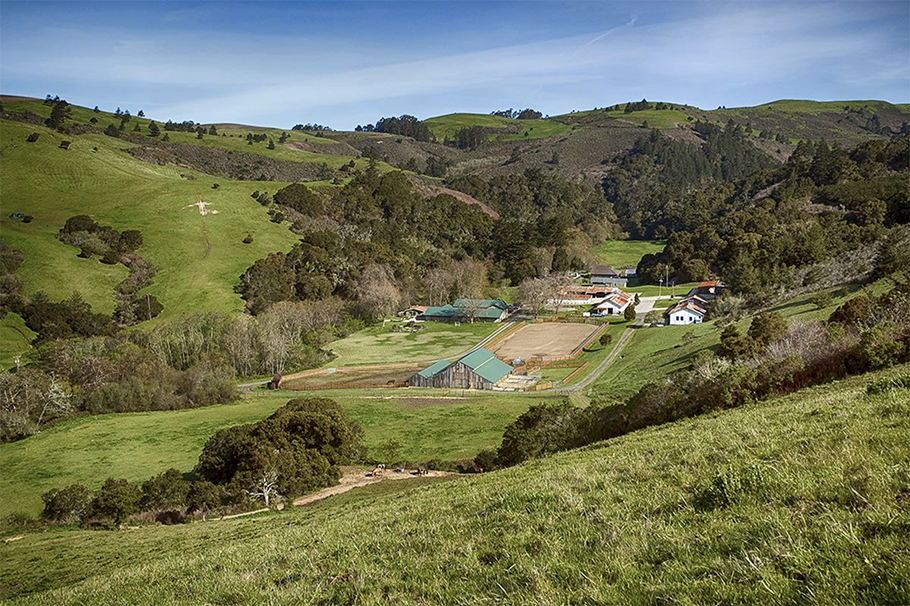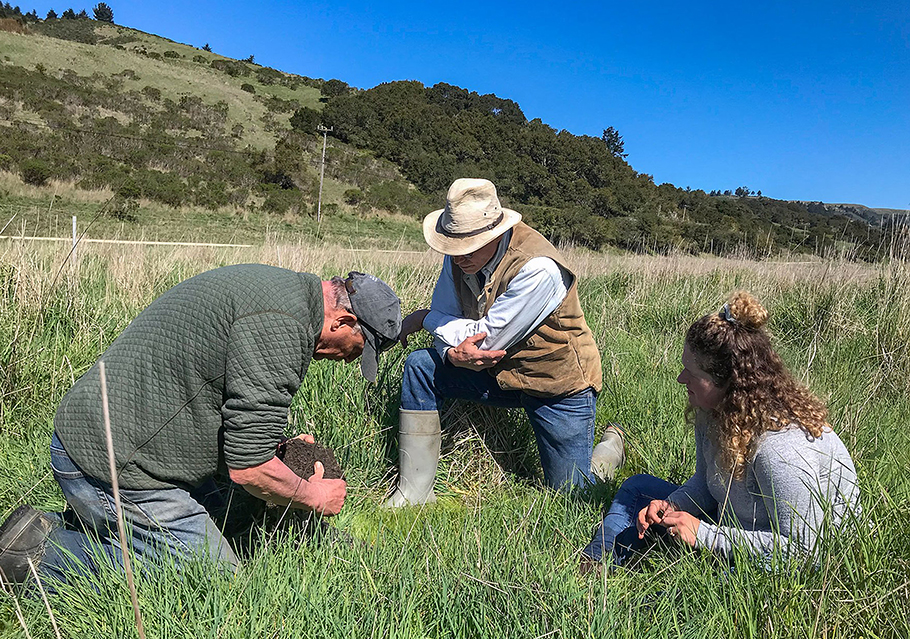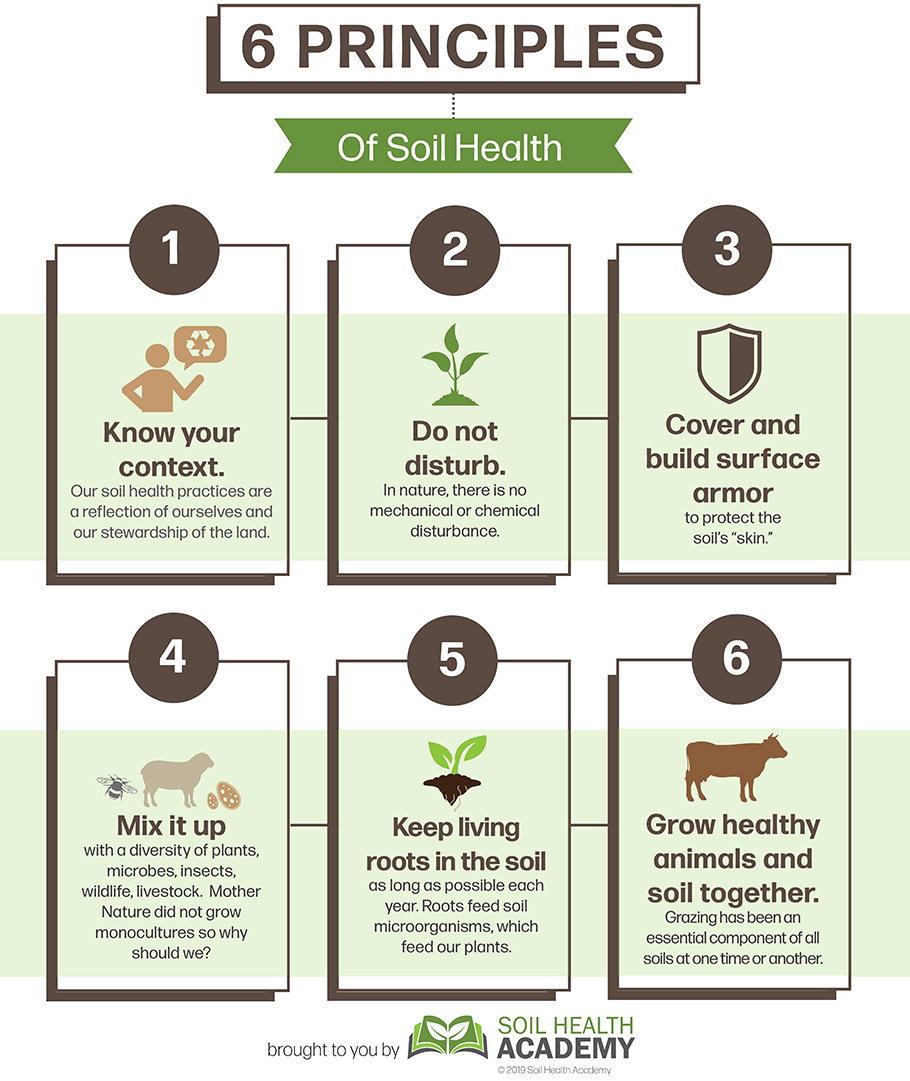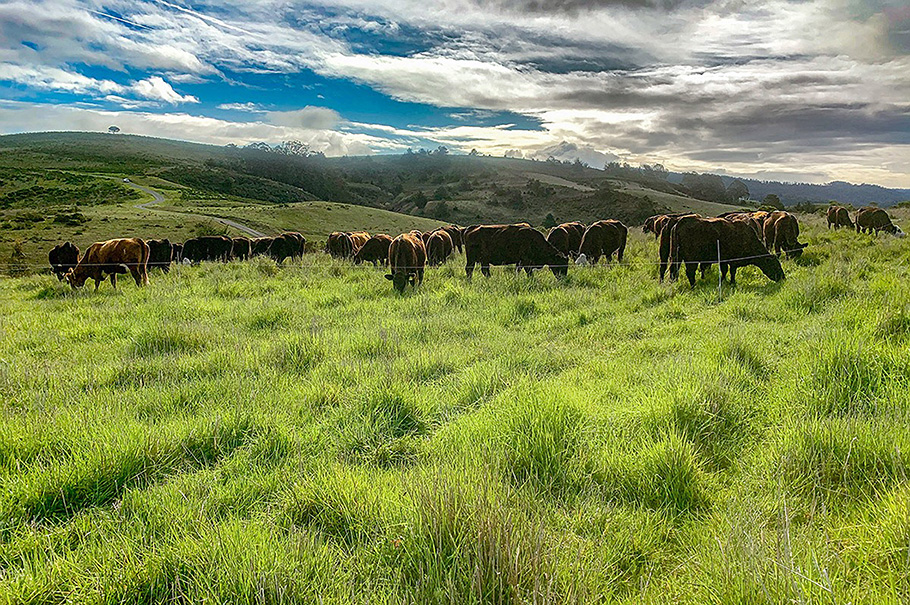
TomKat Ranch

TomKat Ranch in Pescadero, CA
TomKat Ranch (TKR) is an 1,800-acre grass-fed cattle ranch in the San Francisco Bay Area. Its team of ranchers, scientists, and advocates work to inspire and support early adopters of regenerative agriculture and sustainable food systems. Central to their work is discovering, demonstrating, and broadcasting the link between healthy soils, a stable climate, and thriving communities. Mentor-farmer Mark Biaggi, ranch manager at TomKat Ranch, provided an overview on how and why TomKat manages the land they way they do, what they've learned over the years, and his advice for other ranchers and farmers.
 I am, and have been for many years, a student of Regenerative Agriculture (RA), long before I was aware the term existed. I have begged, borrowed, and copied the work of others who came before me as well as my contemporaries in this world today—taking those ideas and adjusting them to fit my context so that they have the most potential to succeed in our given environment and current conditions. It is, therefore, in the spirit of gratitude that I am excited to share what I’ve learned so others may benefit from it and hopefully improve upon it.
I am, and have been for many years, a student of Regenerative Agriculture (RA), long before I was aware the term existed. I have begged, borrowed, and copied the work of others who came before me as well as my contemporaries in this world today—taking those ideas and adjusting them to fit my context so that they have the most potential to succeed in our given environment and current conditions. It is, therefore, in the spirit of gratitude that I am excited to share what I’ve learned so others may benefit from it and hopefully improve upon it.
TKR is located on the historic lands of the Ramaytush people that were taken from them during European colonization. Throughout the 20th century, the ranch was largely operated as a dairy with livestock grazing and for the cultivation of hay and flax. Because of overgrazing, repeated tillage, and even the sale of topsoil, the ranch was in a poor ecological state when it was purchased by its current owners in 2002.
The ranch's owners were inspired by people like Allan Savory and Julius Ruechel to explore how livestock could contribute positively to the ecological health of the ranch and the community at large. TKR initially adopted regenerative management as a strategy to promote ecological restoration of the ranch and, in partnership with Point Blue Conservation Science, carefully documented and shared the successes and failures of that effort. Learning from this process and from luminaries in the field, TKR now not only uses regenerative agriculture for ecological restoration, but also for promoting rural economic opportunity, supporting a stable climate, growing resilient local food systems, and increasing racial and gender equity. (Read about their Growing the Table project.) Our mission today is to provide healthy food on working lands in a way that regenerates the planet and inspires others to action.
Researching Regenerative Ranching on the California Coast
TomKat Ranch operates as a non-profit learning laboratory to discover, demonstrate, de-risk, and broadcast practices that increase the productivity and resilience of working rangelands. Our agricultural practices are not managed to generate a profit for our organization. Instead, we deploy our financial resources to run experiments or conduct outreach that for-profit producers may not be currently able or incentivized to do. Our primary ranch management approaches include:
- Holistic and Inclusive Planning
- Scientific/Observational Monitoring
- Adaptive Planned Grazing (portable electric fencing, low-stress animal handling)
- Partnership and Collaboration
TomKat Ranch began the journey of regenerating its lands in 2010 when it began an extensive ecological monitoring program with Point Blue Conservation Science and switched from set stock to rotational grazing, and eventually transitioned to adaptive planned grazing management. I took the job of Ranch Manager in 2017 because I wanted to participate in this experiment and help explore regenerative practices that are well-suited to our Mediterranean climate.
The basics of how we at TomKat Ranch practice regenerative ranching are similar to land managers who practice adaptive or holistic grazing: place livestock at the right place and in the correct intensity and duration to achieve a balance of animal performance, forage production, and soil health building while providing sufficient rest and recovery for the forage. Our management decisions prioritize the synergistic interplay of soil health and forage production, reduce the need for supplemental hay, and support biodiversity of soil microbes, plants, animals, and pollinators. We also trial practices that will regenerate the land and support scientific efforts and data on the impacts of regenerative practices.
Our approach takes into consideration environmental, economic, and social costs and benefits. Over the last 10 years, we have worked with Holistic Management, REX Farm Planning, Carbon Farm Planning, and grazing and conservation planning. Each effort provides useful information about the ranch’s management impacts.
Monitoring at TomKat Ranch
In addition to planning, we carefully monitor the results of management, trials, and experiments through our partnership with Point Blue Conservation Science and their Rangeland Monitoring Network (see graphic above). Monitoring gives credibility to our findings and lets us know when we should adapt, adjust, or change course altogether. We currently monitor:
- Management practices and trials
- Patterns and diversity of vegetation cover and trends
- Patterns and trends in bird species richness and abundance
- Soil organic carbon, bulk density (compaction), water infiltration, nutrient content, and proportions and composition of soil microbes
- Stream temperature, flow, and depth
- Weather patterns
We realize that working with a conservation science partner isn’t a scalable solution for most ranchers, so we make our data and findings publicly available and provide staff time and expertise to run trials of technologies that can decrease the cost of monitoring for others. These trials have included soil carbon tests with handheld soil spectrometers and remote sensing to analyze bareground and plant diversity.

Observations on the Ranch
The data collected on the ranch make it possible to see how management practices and weather patterns correlate with changes in soil, water, vegetation, and biodiversity, and help guide our management decisions. That said, record high temperatures and extreme drought conditions in most years since 2010 (when the weather station was established) make it challenging to know whether changes are due to management, local soil conditions, weather, or the relationship of these factors.
Overall, we have observed improved soil health from the impacts of adaptive grazing—as the cattle cycle carbon through grazing and depositing urine and manure. In addition, their impact encourages ecosystem benefits such as increased water infiltration that can provide resiliency in times of drought, improve plant production and biodiversity, improve water quality in streams through reduced erosion and run-off, replenish aquifers, and greater greenhouse gas sequestration and mitigated emissions.
Some other interesting observations we’ve seen since adopting Holistic Management and adaptive planned grazing are:
- Increases in vegetation diversity (especially perennial and native grasses) across most of the ranch, with some declines.
- Declines in bare ground and invasive weeds across the ranch (a positive indication), improved levels of soil compaction and water infiltration, with some declines likely related to drought.
- Increased soil carbon at 46% of sites tested. Soil organic carbon declined somewhat during periods of intense drought, but typically not at deeper depths.
- Improved nutrient concentrations related to plant growth.
- Improved soil microbe richness.
- High bird species richness along the riparian area that runs through the ranch, but slight declines in the grasslands.
Nature is complex so these observations often lead to more questions. In particular, why are improvements seen in some locations and declines in others? The answers may be related to topography, mineral content of the soil, the legacy impact of past farming practices in these locations, or something we don’t yet understand. We will continue testing and experimenting to discover the keys to improving the conditions on the California coast in our changing climate.
Context is Key: How I Approach Regenerative Agriculture
What is the best way to approach regenerative agriculture (RA)? Consider it a long journey—a journey of a lifetime with no exact “winning” goal at the end, rather a continual thinking process utilizing proven practices.
When beginning with a new concept it is best to understand how it fits within one’s goals, mission, and/or values. If we have worked within a certain framework for a while, we often do not stop to re-evaluate how and where it scores against our goals. RA can fall victim in both these areas. It is both a new and an old concept; it is both simple and complex. It does not have specific guidelines of operation, or governing rules for calibration, validation, or certification. RA cannot be put into a box. It is not a tool in and of itself, but a set of principles for finding the right tools. It is not specific and therefore not conducive to recipes or “best ag practices.”
Some producers in places around the world have practiced it for years and even decades—long before the term “Regenerative Agriculture” was coined. Since the earliest days of agriculture there have been people who are in tune with the land and nature, aware of the value of protecting the soils and the plants while still cultivating the bounty they and their communities needed to thrive. They were practicing regenerative farming.
How we approach RA is the key. This may be more important in the long run than how we implement some of the practices or even which practices we use. We need to recognize that we humans are linear thinkers, good at connecting the dots, solving problems, and producing predictable results. Agriculture is not an entity unto itself but an integral part of the natural world, ultimately governed by the laws of nature which are non-linear. Natural systems are highly complex, multi-circular, incredibly interconnected, and ever changing. Should we ignore the complexity of nature and forge ahead with our linear thinking only, best tools in hand, with a production-only mentality, we eventually create many of the challenges facing the agriculture industry today worldwide. Every decision we make produces corresponding and cascading impacts in the natural world.
To start we must have our ego in check. Is it not the hubris of mankind to think that we can dominate the world, nature, and biology through technological, chemical, and mechanical means to do our bidding? And then to assume that in this domination there will be no negative consequences? Therefore, to succeed within RA—producing food in a way that supports healthy people and a healthy planet—requires a paradigm shift away from the dominating mindset to a mindset of working with nature for a mutual benefit.
In the never-ending search for increasing production, we have continued to adopt the latest most progressive agricultural practices with no regard or awareness of their effect upon nature. We have too often set aside the art of observation, the art of understanding that observation, the skill of modifying both old and new practices and tools to fit the biology that surrounds us. It appears that with all our exceptional modern technology—whether that be chemical, mechanical, technical, medical—we have set aside biology as no longer a partner but as something to dominate and shape into the environment we desire for our production goals. This can and has been moderately successful in the short run, even years to decades, depending on soil fertility and how “cooperative” the weather is at that point in time. It has allowed us to adopt “best practices” that can be detrimental and even self-defeating in the long run.
RA is a set of principles that do not have production and economics as the leading indicator—rather a set of principles that protect and build our foundation, our capital which is the soil health that drives all of agriculture. This is not to say that economics and production are not important; they are one of the important cornerstones to longevity, to sustainability. But a focus on production and profit alone can trade short-term successes for long-term viability.

The above graphic is a factsheet from the Soil Health Academy(opens in new window).
The principles of Regenerative Agriculture as we believe them to be:
- Context—know it
- No bare soil—armor or cover it
- Do not disturb the soil mechanically and if so, as little as possible
- Living roots as much of the year as possible
- Promote biodiversity above and below ground
- Include livestock as diverse as possible
The first principle, context, may be the hardest principle to follow, yet it is the most crucial. Without context we may create or adopt practices that are successful today but are detrimental tomorrow. We may make decisions without truly understanding the influence of the impact upon our soil health and the environment in our farm’s long-term success.
Knowing your context provides insight that the cursory glance does not, and sometimes that even generational knowledge will not. It allows you the power to take the time and apply the mental energy for observing, thinking and testing based on those observations. Context allows us to find and focus on those practices that are a true fit rather than what we have always done, or what is done in our region, or what we want to do, or the latest fad, or. . . Knowing our context is the very first step to working with the land, the soil, the water, and nature. What you introduce via farming and ranching practices to the land must fit your context.
We need to understand the difference between practices and principles. Practices are the equivalent of tools, just on a different scale. While you may have the ability to wield a tool with professional skill, if it is the wrong tool for that particular job, the results are poor. Practices are no different. Agricultural history is littered with the wrecks of introducing crops and livestock unsuited to a given environment.
What is context in the agricultural world? It is understanding who we are, our partners, our families, our employees, and the communities in which we live, work, support, and nourish with food we produce as well as the land we work, the soil that is the land, and the vast microbial communities which organize and maintain soil health. Our context is understanding the relationship on our farm of the microbes below our feet that provide the healthy soil to grow the plants to feed ourselves and our animals. It is understanding the water cycle, the mineral/carbon cycle, the energy cycle, and the community dynamics for our farm. It is understanding where our farm/ranch and our region fall on the brittleness scale—from a tropical ecosystem to a desert ecosystem. Understanding one’s context allows you to make the right decisions on enterprises and practices.
Knowing your context will not prevent you from making mistakes, poor decisions, or facing challenges, but if you understand your context and always keep it in mind, it will provide you a guide throughout all of your decision making processes. Many producers have been impressed by successful practitioners of RA. They have studied and adopted the most common practices advocated by many in the RA community, but without understanding their context they do not find similar success.
Learn and know your context intimately. There are no “How To Do It” instruction manuals. To avoid understanding your context is starting the job with a tool box missing one of the most critical tools. You may or may not get the job completed properly. If you do, it may be due to luck, but you will never know if you could have done a more efficient job with better results had you brought the full complement of tools. For some of us this work is not easy, it is not natural, and it may shine the light on issues we have avoided. Take the time to invest in yourself and your operation: Understand your context.

